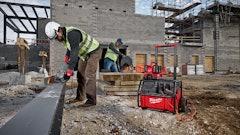Operating LEAN used to be about cutting overhead to increase profits, but for many it’s now about cutting overhead just to remain profitable. In a series developed for Yard & Garden, six components of LEAN operation were covered—areas that can be revisited and reworked to create LEAN operation in your dealership. The series covered stock levels, overproduction, transportation, processing, defective product, waiting and motion. Read on to learn how paperless processing can get you on your way to operating LEAN.
Processing in a LEAN manner means delivering the right work to the right people at the right time, all while reducing—and sometimes eliminating—the need for paperwork. When done right, LEAN processing can improve productivity, as well as reduce operating costs and errors. Every small reduction in wasted time and money can help increase dealership profits.
The act of processing is done throughout the dealership. It encompasses shop service orders, equipment registrations and warranties, as well as parts and wholegoods purchase orders. Basically, anything done on paper needs processing.
DELEGATING TASKS
In processing, there needs to be assigned tasks and accountability. This ensures the work is done, and with accountability comes reduced error. Dealers typically assign specific employees to certain tasks. Jerry Clay of Clay’s Outdoor Power Equipment in Raleigh, NC, has done just that with product line management. “Each salesperson is assigned a product line,” explains Clay. “They are each in charge of making sure things are priced right and properly displayed, all while keeping an eye on equipment levels and suggesting orders.” Employees write up equipment purchase orders for Clay to approve.
With the individual assignments, lines are well managed and employees are invested. “They appreciate the responsibility because it makes them feel good to be in charge of it,” says Clay. “It helps me as I try to delegate as much as I can.”
Clay has also improved equipment registration with the creation of his own warranty form that gathers information and assigns tasks throughout the sale. “I created a generic warranty form that we fill out with each equipment sale,” explains Clay. “I took elements from all the different manufacturer forms we deal with and put them all in one form.” This eliminates the need for multiple warranty forms, further reducing error.
“The form also has space for the salesperson to put their initials at the sale. I add mine when I pay off the floor plan, and the person who registers it also initials,” explains Clay. “By having everyone put their initials on it we know exactly what stages we are in.”
The customer fills out their personal information on the form, which is also attached to a brief customer service survey. Once the custom-made form is filled out, it goes into the salesperson’s folder. Each has their own folder.
BMS TOOLS
A great tool for improving processing is a business management system. “A well-tuned BMS provides the business manager with the necessary information to delegate to his employees things that are critical and should take priority,” says Jim Archut of c-Systems Software. “In the grand scheme of things, each of these employees should know their jobs well enough and have enough access to the relevant BMS data that will guide them through what needs to be done.” They can also decide which employees have access to certain features within the BMS.
A properly utilized BMS helps improve processing and overall customer service. “Having all information about customers, purchases, and work orders in one system greatly saves time and improves customer service,” ensures Jeff Haefner of Ideal Computer Systems. “This enables any of your employees to answer customer questions instead of having to pull techs or managers, who worked on previous projects, away from their current tasks.”
A BMS can help greatly when managing equipment and parts inventories, helping employees track levels and generate purchase orders with ease. “Using the minimum and maximum stocking level features for seasonal ordering levels is a huge benefit for dealers because you can instantly create order recommendations in your system based off those levels,” says Haefner. “You can also run a recommendation off of a percentage of sales history. In times like these where people are tracking and can see that they are a little off of what they normally do, they can make recommendations on a percentage of sales history or a percentage of their normal stocking level.”
Additionally, dealers save time by processing purchase orders within the system and not manually entering them in. “Not having to fax or mail in orders saves on time, postage and paper,” explains Clay. “It also leaves less room for error in data entry.”
GOING PAPERLESS
There are many tools available that allow dealers to reduce or even eliminate the need for paperwork in processing. It’s leading many dealers to consider going paperless. “I’m thinking about going electronic with processing, but I’m not sure how,” says Clay. A good place for Clay to start his transition may be with a signature capture pad, because he could immediately enjoy its benefits. “The biggest advantage is not having to waste time going through files and finding old papers that contain signatures,” explains Haefner. “Digital signatures also help hold customers accountable because you can see directly from the system who signed and agreed to a repair on a unit, and who picked it up.” For dealers, having the ability to access that information so quickly helps in serving customers quickly and efficiently.
From there, dealers can move into the scanning and digitizing of any documents that come into the dealership for processing. Having the digital copies allows them to be emailed with ease between dealership locations, to employees, customers or suppliers, once again reducing the wasteful movement of paper around the company.
While paperless processing has its benefits, there are times when it may not be the most practical. Take the shop, for instance. “In many cases, it still makes more sense for mechanics to have a ‘hard copy’ of a work order in which to write notes and suggest additional service repairs,” says Archut. “Although more and more mechanics have their own workstation, a hard copy is still practical.”
Dealers should learn all about their BMS features and decide how they can help improve processing procedures. Knowing what paperless features can and can’t work for your business is up to you, but improving processing in some way can reduce waste and save time, improving customer satisfaction overall.


























